The Sensor Based Glucose Measuring Systems Market is estimated to be valued at USD 12.8 billion in 2025 and is projected to reach USD 34.8 billion by 2035, registering a compound annual growth rate (CAGR) of 10.5% over the forecast period.
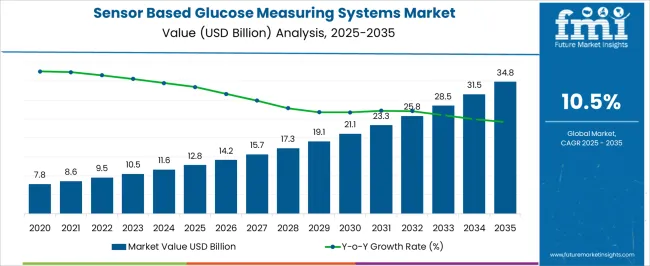
| Metric | Value |
|---|---|
| Sensor Based Glucose Measuring Systems Market Estimated Value in (2025 E) | USD 12.8 billion |
| Sensor Based Glucose Measuring Systems Market Forecast Value in (2035 F) | USD 34.8 billion |
| Forecast CAGR (2025 to 2035) | 10.5% |
The Sensor Based Glucose Measuring Systems market is witnessing strong growth driven by rising prevalence of diabetes, growing awareness about continuous health monitoring, and increasing adoption of connected healthcare technologies. The market is currently being shaped by the demand for real-time, accurate, and non-invasive glucose monitoring solutions that empower patients and healthcare providers to manage diabetes more effectively.
Investment in advanced sensors, data analytics, and wearable technologies is facilitating the development of intelligent systems that integrate seamlessly with smartphones and cloud-based health management platforms. Additionally, regulatory approvals and increased reimbursement policies in several regions are enhancing the accessibility of sensor-based glucose devices.
With a growing focus on preventive care and personalized therapy, continuous glucose monitoring solutions are being preferred over traditional finger-prick methods, providing actionable insights for lifestyle and medication adjustments The expanding geriatric population, urban lifestyle-driven diabetes incidence, and the rising trend of home-based healthcare monitoring are further fueling market growth, positioning the market for sustained expansion in the coming decade.
The sensor based glucose measuring systems market is segmented by application, distribution site user, product, end use, and geographic regions. By application, sensor based glucose measuring systems market is divided into Type 2 Diabetes, Type 1 Diabetes, and Gestational diabetes. In terms of distribution site user, sensor based glucose measuring systems market is classified into Retail pharmacy, Drug stores, E-commerce, and Hospital. Based on product, sensor based glucose measuring systems market is segmented into Continuous glucose monitoring system, Self-monitoring blood glucose system, Glucose meter, Testing strips, Lancets, Sensor, Transmitter, and Insulin pump. By end use, sensor based glucose measuring systems market is segmented into Homecare, Hospitals, Diagnostic center, and Clinics. Regionally, the sensor based glucose measuring systems industry is classified into North America, Latin America, Western Europe, Eastern Europe, Balkan & Baltic Countries, Russia & Belarus, Central Asia, East Asia, South Asia & Pacific, and the Middle East & Africa.
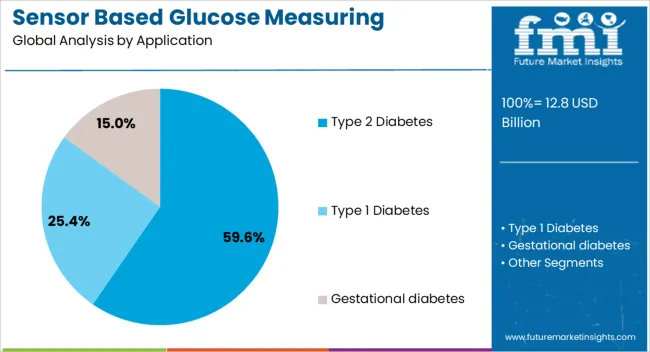
The Type 2 Diabetes application segment is projected to account for 59.60% of the overall Sensor Based Glucose Measuring Systems market revenue in 2025, making it the leading application. This dominance has been driven by the high prevalence of Type 2 Diabetes globally and the increasing need for continuous monitoring among patients to manage blood glucose fluctuations effectively.
Adoption has been facilitated by the availability of non-invasive and wearable sensor technologies, which enhance patient compliance and reduce the burden of traditional monitoring. Continuous monitoring enables early detection of hyperglycemic and hypoglycemic episodes, supporting better treatment decisions and improved patient outcomes.
The segment growth has also been reinforced by integration with telemedicine platforms and mobile health applications, allowing healthcare providers to remotely track patient data As Type 2 Diabetes management increasingly focuses on real-time data, predictive analytics, and personalized therapy adjustments, the demand for sensor-based glucose measuring systems in this application is expected to remain robust and continue to dominate the market share.
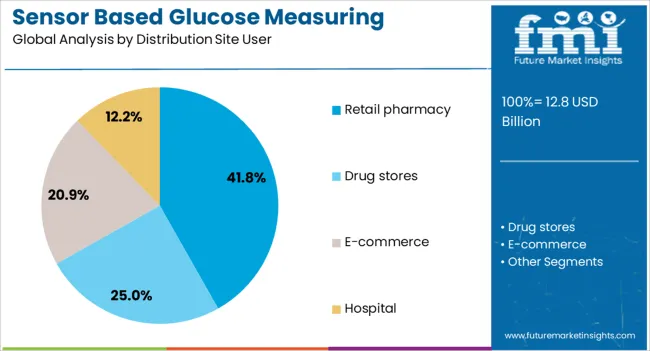
The Retail Pharmacy distribution site segment is expected to hold 41.80% of the total market revenue in 2025, emerging as the leading distribution channel. Growth in this segment has been driven by the convenience and accessibility of pharmacies for end-users seeking sensor-based glucose devices. Retail pharmacies provide a wide range of product options, immediate availability, and professional guidance, which helps patients make informed purchasing decisions.
The presence of trained staff to explain device usage and assist with setup has further encouraged adoption. In addition, pharmacies often serve as primary points for insurance coverage and reimbursement claims, making them a preferred channel for patients seeking cost-effective and supported access to continuous glucose monitoring systems.
The ability to combine sales with routine consultations and lifestyle counseling has reinforced the relevance of this channel As healthcare systems continue to focus on patient-centered care and improve access to advanced monitoring technologies, the retail pharmacy segment is expected to retain its leadership in the distribution landscape.
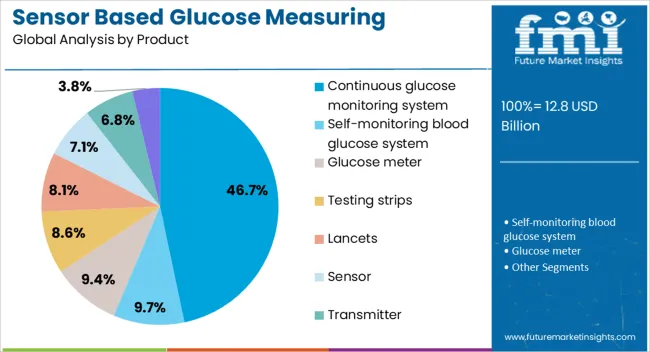
The Continuous Glucose Monitoring System product segment is projected to capture 46.70% of the market revenue in 2025, positioning it as the leading product type. The growth of this segment has been driven by the increasing adoption of wearable sensors that provide real-time glucose data and actionable insights without the need for frequent finger-prick tests.
Continuous monitoring has become critical for both patients and healthcare providers to manage glucose variability effectively, prevent complications, and optimize treatment regimens. Technological advancements, such as integration with mobile devices, predictive analytics, and cloud-based data management, have enhanced usability and patient engagement.
The segment has also benefitted from rising awareness about the advantages of continuous monitoring in improving adherence, detecting trends, and supporting lifestyle modifications As diabetes management shifts toward personalized care and remote monitoring, continuous glucose monitoring systems are expected to remain the dominant product choice, reinforcing their market leadership in terms of revenue share.
Sensor Based Glucose Measuring Systems are used to monitor and analyze blood glucose levels in various healthcare settings and are becoming an integral part of personalized healthcare monitoring. Diabetes affects worldwide and Diabetics patients have to check their blood sugar several times a day.
Usually patient or nurse pricks the finger for the test. Sensor Based Glucose Measuring Systems is easy to handle, easy to carry and easy to use and also help to keep glucose level under control. With the help of Sensor Based Glucose Measuring devices can monitor and regulate glucose levels regularly.
Sensor-based glucose measuring systems also called self-monitoring devices used in glucose monitoring at any condition and anywhere and can also treat quickly such as hypo and hyperglycemia. In 1970, firstly Sensor Based Glucose Measuring Systems were introduced in the market. There are different types of Sensor Based Glucose Measuring Systems available for different professional and personal care.
The Sensor Based Glucose Measuring System is more convenient and reliable for diabetic patients. Sensor-based devices is indicated for both type of diabetic patients and provide information about glucose level at every moment. Continuous glucose monitoring by a sensor-based glucose measuring system is very helpful in diabetic's patients.
In the market, there are different wireless, mobile apps and smart cloud, multi-sensor based non-invasive, continuous glucometer and glucose testing devices available. At-home glucose tracking is very common because of Sensor Based Glucose Measuring Systems. Diabetic adult patients using Sensor Based Glucose Measuring Systems.
Some of the Sensor Based Glucose Measuring Systems are very expensive and they require sensors every month. The price of the sensor depends on the brand of the products. The sensor of these devices measures blood glucose based on interstitial fluid. Having attached to the body is sometimes annoying. Sensor Based Glucose Measuring Systems are not comfort in MRI, CT scan, X-ray, or diathermy treatment.
Demand for Sensor Based Glucose Measuring Systems is driven by the rising prevalence of diabetes globally and the growing adoption of minimally invasive and non-invasive healthcare modalities is one of the major factors driving the sensor-based glucose measuring system market. Currently, there are approximately 350 million people worldwide diseased with diabetes.
The growing adoption of Sensor Based Glucose Measuring Systems amongst a considerable diabetic patient pool is expected to fuel the growth of the global Sensor Based Glucose Measuring Systems market. Along with Sensor Based Glucose Measuring Systems are considerably developing personalized apps which deliver personalized advice and alerts, helping a patient to independently manage his or her condition, thus fueling the growth of sensor-based glucose Measuring Systems.
On the basis of geography, Sensor Based Glucose Measuring Systems Market is segmented into several key regions viz. North America, Latin America, Western Europe, Eastern Europe, and Asia Pacific excluding Japan, Japan, and Middle East & Africa. The incidence of diabetes is higher in regions such as Asia Pacific, North America and Western Europe. North America expected to register the fastest growth in the global blood glucose testing devices, due to large patient pool and awareness of advanced technology and high demand of diabetes care products.
Due to lifestyle, prevalence of obesity is very high and other environmental factor escalates diabetic population. Major factor such as price analysis, supply chain analysis, political, social and technical also provide forecast number of market for sensor based glucose measuring system. Europe and Asia pacific region are also foresees to market moderate rate.
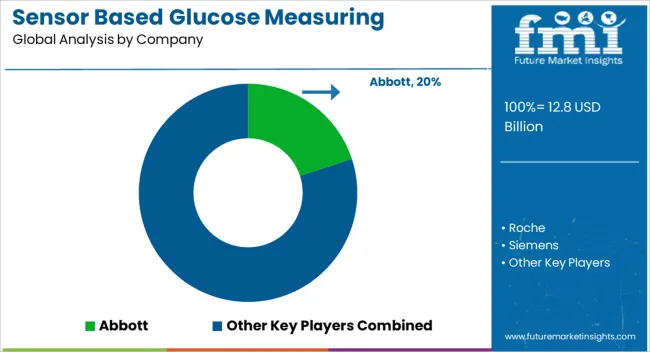
Sensor Based Glucose Measuring Systems which would exceed industry standards are being developed, and manufactured by key industry leaders. The major key players in the sensor-based glucose measuring system are Roche, Abbott, Siemens Healthcare Diagnostics, Nova Biomedical Corp, Animas Corporation, M-Biotech, LifeScan, AgaMatrix, Medtronic Diabetes and others.
The report is a compilation of first-hand information, qualitative and quantitative assessments by industry analysts, and inputs from industry experts and industry participants across the value chain. The report provides an in-depth analysis of parent market trends, macro-economic indicators and governing factors along with market attractiveness as per segments. The report also maps the qualitative impact of various market factors on market segments and geographies.
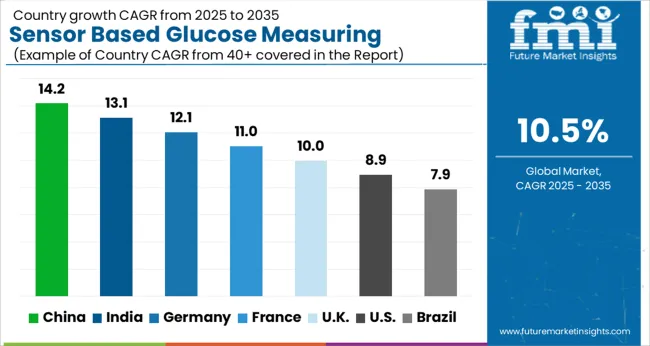
| Country | CAGR |
|---|---|
| China | 14.2% |
| India | 13.1% |
| Germany | 12.1% |
| France | 11.0% |
| UK | 10.0% |
| USA | 8.9% |
| Brazil | 7.9% |
The Sensor Based Glucose Measuring Systems Market is expected to register a CAGR of 10.5% during the forecast period, exhibiting varied country level momentum. China leads with the highest CAGR of 14.2%, followed by India at 13.1%. Developed markets such as Germany, France, and the UK continue to expand steadily, while the USA is likely to grow at consistent rates. Brazil posts the lowest CAGR at 7.9%, yet still underscores a broadly positive trajectory for the global Sensor Based Glucose Measuring Systems Market. In 2024, Germany held a dominant revenue in the Western Europe market and is expected to grow with a CAGR of 12.1%. The USA Sensor Based Glucose Measuring Systems Market is estimated to be valued at USD 4.8 billion in 2025 and is anticipated to reach a valuation of USD 11.2 billion by 2035. Sales are projected to rise at a CAGR of 8.9% over the forecast period between 2025 and 2035. While Japan and South Korea markets are estimated to be valued at USD 680.7 million and USD 323.9 million respectively in 2025.
| Item | Value |
|---|---|
| Quantitative Units | USD 12.8 Billion |
| Application | Type 2 Diabetes, Type 1 Diabetes, and Gestational diabetes |
| Distribution Site User | Retail pharmacy, Drug stores, E-commerce, and Hospital |
| Product | Continuous glucose monitoring system, Self-monitoring blood glucose system, Glucose meter, Testing strips, Lancets, Sensor, Transmitter, and Insulin pump |
| End Use | Homecare, Hospitals, Diagnostic center, and Clinics |
| Regions Covered | North America, Europe, Asia-Pacific, Latin America, Middle East & Africa |
| Country Covered | United States, Canada, Germany, France, United Kingdom, China, Japan, India, Brazil, South Africa |
| Key Companies Profiled | Abbott, Roche, Siemens, Nova Biomedical, Johnson & Johnson, Danaher, LifeScan, AgaMatrix, and Medtronic |
The global sensor based glucose measuring systems market is estimated to be valued at USD 12.8 billion in 2025.
The market size for the sensor based glucose measuring systems market is projected to reach USD 34.8 billion by 2035.
The sensor based glucose measuring systems market is expected to grow at a 10.5% CAGR between 2025 and 2035.
The key product types in sensor based glucose measuring systems market are type 2 diabetes, type 1 diabetes and gestational diabetes.
In terms of distribution site user, retail pharmacy segment to command 41.8% share in the sensor based glucose measuring systems market in 2025.






Our Research Products

The "Full Research Suite" delivers actionable market intel, deep dives on markets or technologies, so clients act faster, cut risk, and unlock growth.

The Leaderboard benchmarks and ranks top vendors, classifying them as Established Leaders, Leading Challengers, or Disruptors & Challengers.

Locates where complements amplify value and substitutes erode it, forecasting net impact by horizon

We deliver granular, decision-grade intel: market sizing, 5-year forecasts, pricing, adoption, usage, revenue, and operational KPIs—plus competitor tracking, regulation, and value chains—across 60 countries broadly.

Spot the shifts before they hit your P&L. We track inflection points, adoption curves, pricing moves, and ecosystem plays to show where demand is heading, why it is changing, and what to do next across high-growth markets and disruptive tech

Real-time reads of user behavior. We track shifting priorities, perceptions of today’s and next-gen services, and provider experience, then pace how fast tech moves from trial to adoption, blending buyer, consumer, and channel inputs with social signals (#WhySwitch, #UX).

Partner with our analyst team to build a custom report designed around your business priorities. From analysing market trends to assessing competitors or crafting bespoke datasets, we tailor insights to your needs.
Supplier Intelligence
Discovery & Profiling
Capacity & Footprint
Performance & Risk
Compliance & Governance
Commercial Readiness
Who Supplies Whom
Scorecards & Shortlists
Playbooks & Docs
Category Intelligence
Definition & Scope
Demand & Use Cases
Cost Drivers
Market Structure
Supply Chain Map
Trade & Policy
Operating Norms
Deliverables
Buyer Intelligence
Account Basics
Spend & Scope
Procurement Model
Vendor Requirements
Terms & Policies
Entry Strategy
Pain Points & Triggers
Outputs
Pricing Analysis
Benchmarks
Trends
Should-Cost
Indexation
Landed Cost
Commercial Terms
Deliverables
Brand Analysis
Positioning & Value Prop
Share & Presence
Customer Evidence
Go-to-Market
Digital & Reputation
Compliance & Trust
KPIs & Gaps
Outputs
Full Research Suite comprises of:
Market outlook & trends analysis
Interviews & case studies
Strategic recommendations
Vendor profiles & capabilities analysis
5-year forecasts
8 regions and 60+ country-level data splits
Market segment data splits
12 months of continuous data updates
DELIVERED AS:
PDF EXCEL ONLINE
Sensor Data Analytics Market Size and Share Forecast Outlook 2025 to 2035
Sensor Testing Market Forecast Outlook 2025 to 2035
Sensor Fusion Market Size and Share Forecast Outlook 2025 to 2035
Sensor Development Kit Market Size and Share Forecast Outlook 2025 to 2035
Sensory Modifier Market Size and Share Forecast Outlook 2025 to 2035
Sensor Bearings Market Insights - Growth & Forecast 2025 to 2035
Sensor Hub Market Analysis - Growth, Demand & Forecast 2025 to 2035
Sensor Patches Market Analysis - Growth, Applications & Outlook 2025 to 2035
Sensors Market Analysis by Type, Technology, End User & Region - Forecast from 2025 to 2035
Sensor Cable Market
Sensormatic Labels Market
3D Sensor Market Size and Share Forecast Outlook 2025 to 2035
Biosensors Market Trends – Growth & Future Outlook 2025 to 2035
UV Sensors Market Analysis by Type, End User, and Region from 2025 to 2035
CP Sensor for Consumer Applications Market – Growth & Forecast 2025 to 2035
Nanosensors Market Size and Share Forecast Outlook 2025 to 2035
NOx Sensor Market Size and Share Forecast Outlook 2025 to 2035
VOC Sensors and Monitors Market Analysis - Size, Growth, and Forecast 2025 to 2035
Rain Sensors Market Size and Share Forecast Outlook 2025 to 2035
Microsensor Market Size and Share Forecast Outlook 2025 to 2035

Thank you!
You will receive an email from our Business Development Manager. Please be sure to check your SPAM/JUNK folder too.
Chat With
MaRIA